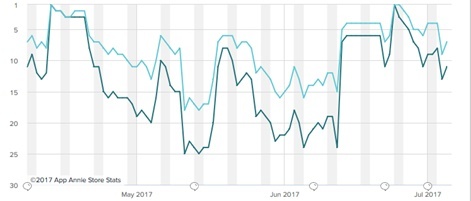Augmented reality and location-based mobile game Pokemon GO was launched a year ago today on July 6th 2016.
It was far from a smooth release. The mammoth popularity of an IP that was now available for free on mobile devices caused significant issues for developer Niantic. Its servers were overrun.
Just take a look at this graph from Google Cloud of expectations versus the reality.

It was a significant jump that it could never have anticipated.
The servers were further hampered by the easy access to the game's APK for Android users around the world, all eager to get their hands on the game before its official launch in their country.
This compounded the issue for Niantic, as it had to handle players in more countries than its planned rollout had accounted for.
But it eventually overcame those issues to become a cultural phenomenon and rack up as many as, according to some sources, 28.5 million daily active users at its peak.
One of the biggest mobile games ever
Within seven months, Sensor Tower claimed the game had surpassed $1 billion in revenue from in-app purchases. A record setting pace.
And it doesn’t just make money from those IAPs. A Niantic spokesperson recently revealed it charges up to $0.50 per visitor at special sponsored locations.
It was estimated that through a partnership with McDonalds Japan, which resulted in 2,000 visitors each day at 3,000 stores, could have generated the company anywhere between $900,000 and $3 million.
Niantic has unlocked a potential new revenue stream for games companies with Pokemon GO. Though certainly there are very few IPs with the widespread global appeal and nostalgia that Pokemon brings with it, so it's not something that would be easily replicated by just any game.
As of June 2017, Pokemon GO had been downloaded more than 750 million times across the globe.
Not a fad
So one year on to the day since its launch, how is the game faring now?
We recently published an article showing stats between November 2016 and March 2017. It showed that as recently as March 2017, according to Reflection data, Pokemon GO was still a regular top 10 grosser on the App Store.
Much of this is down to the astute live operations run by the Niantic team. The release of new pokemon is an easy win for the studio, but its ability to attract players back and generate bigger revenue with special events, typically related to public holidays, has provided fruitful returns.
According to App Annie data, during the last three months Pokemon GO’s grossing position has fluctuated greatly, but it has still never dropped out of the App Store’s top 25 grossing rankings in the US.
And don’t forget – that doesn’t take into account any money earned from sponsored locations.
The game shot back up the charts on June 13th from 24th to seventh, even hitting the top grossing spot on June 24th.
Since then it’s spent most of its time in the top 10.

Eye on retention
The sudden jump to top spot can be put down to the revamped gym battles, arguably the weakest part of Pokemon GO, and the addition of cooperative Raid Battles.
Gyms now have six permanent slots for the team that 'owns' it to fill with pokemon. Prior to the update, this had been restrictured to an initial three pokemon, with players having to level up their team's gym to open new slots by conducting numerous training battles.
It was a repetitive task and holding gyms became particularly difficult without the ability to coordinate with others, while an attacking trainer from an opposing team could use six pokemon from the get-go.
A new motivation system has also been introduced for pokemon at gyms. Players now have to actively return to a gym they've left pokemon at and feed their pokemon berries to maintain its combat power.
This also feeds into the games location-based foundations and creates a gameplay loop - players will regularly need to head to various pokestops to get more berries (as well as other items like potions and revives), to help keep gyms and take over new ones/reclaim old ones.

Meanwhile, through co-operative Raid Battles players can team up with other trainers to defeat powerful pokemon during timed in-game events at gyms, giving users the opportunity to obtain new items. For the first time, users are able to create private Raid groups through a special code system, enabling them to better co-ordinate these battles.
All of these new additions create much better retention and offer players a reason to come back beyond just catching them all.
Global success story
It’s not just the US where Pokemon GO remains a success. While in Japan it has certainly dropped in popularity, it occasionally still spends time in the top 10 grossing positions on the App Store. It typically hovers around the top 20 and 30 positions, though has fallen as low as 67th.
Pokemon GO remains a stalwart of the top 20 and top 10 grossing positions in countries like Germany, the UK and France.
In South Korea however, it has struggled more and fallen out of the top 100 grossing positions at times during the last month. As of July 6th it was ranked in 89th spot.
According to SuperData, the title fell out of the worldwide top 10 grossing charts in May 2017 for the first time. Again however, this only takes into accounts IAP revenue estimates and not other sources of income.
So a year on, while it's not a completely rosy picture that retains its astronomic highs in the weeks following its launch, Pokemon GO remains a hit for Niantic and has proven itself far from a fad.
But it could be some time before we see another game utilise location-based technology and augmented reality to create another hit at the scale of Pokemon GO - if indeed we ever will.
It's hardly ushered in a new era of AR and location-based gaming - though there has been huge investment in the technology for augmented reality since its launch, there have been no real imitators on the same scale in the games space.
Pokemon GO's (continued) success is unique and came about through the combination of a myriad of factors that include the right IP, tech, developer and time.




















